By Wayne Gillam / UW ECE News
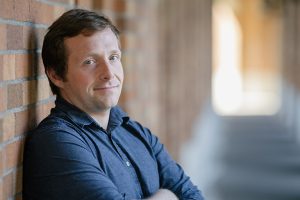
UW ECE Research Assistant Professor Max Parsons develops cold atom systems that use precise optical control of qubits for quantum computing, sensing, and communication. He also directs the Quantum Technologies Training and Testbed (QT3) Lab, which is equipped with state-of-the-art hardware and provides unique opportunities for students to gain hands-on experience exploring quantum phenomena in an interdisciplinary environment. Photo by Ryan Hoover / UW ECE
UW ECE Research Assistant Professor Max Parsons says that he is interested in big, tough-to-solve science and engineering problems, anything where there might be a large question mark in people’s minds. Perhaps that interest is what drew him to focus on one of the most difficult and complex challenges of our time — making the promise of quantum computers and related technologies a practical reality.
Understanding quantum mechanics has enabled scientists and engineers to make great strides over the last several decades, producing sophisticated devices, such as magnetic resonance imaging (MRI) scanners, lasers, solar cells, electron microscopes, and atomic clocks. And in recent years, quantum technology has been made much of in the media. Quantum computers have the potential to significantly outpace the fastest supercomputers in existence today, making revolutionary advances possible in areas such as communications, cryptography, and drug discovery. However, there are many challenges ahead before engineers can make this lofty vision a reality, including managing errors in sensitive quantum systems, developing high-quality hardware, and building quantum computers to a scale needed for practical tasks. Parsons seeks to address these challenges, especially scaling up quantum computers.
To this end, Parsons is focusing on increasing the number of usable qubits in a quantum computer. A qubit is the basic unit of information in quantum computing, and it is created by manipulating and measuring quantum particles, such as photons, electrons, trapped ions, superconducting circuits, or atoms. To date, the world record for the most number of qubits in a quantum computer is a little over 1,000. But quantum computers will need to be capable of managing close to a million qubits to be useful for solving real-world problems. Parsons is working toward bridging that wide gap. He develops cold atom systems that use precise optical control of qubits for quantum computing, communication, and sensing. He also directs the Quantum Technologies Training and Testbed (QT3) Lab, which is equipped with state-of-the-art hardware and provides unique opportunities for students to gain hands-on experience exploring quantum phenomena in an interdisciplinary environment.
A path from academia to industry and back again
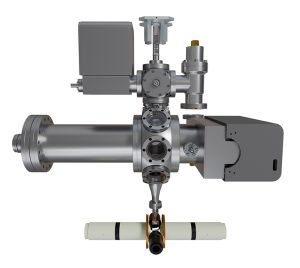
This illustration shows a vacuum chamber for a neutral atom quantum processor developed by Parsons. At the top of the illustration is a pyrex glass cell containing lasers and magnets that create a beam of rubidium atoms, which are directed downward. After passing through the middle of the device, which provides high-speed vacuum pumping and optical access for further atomic beam preparation, the atoms are moved into another glass cell. There, they are trapped in the middle of four microscopes, which can project precise light fields produced and controlled by digital holograms and photonic integrated circuits to trap single atoms, cool them to a few millionths of a degree above absolute zero, and manipulate their quantum states to perform quantum computations. Illustration provided by Max Parsons.
Parsons’ interest in quantum phenomena began as a child. He enjoyed reading popular physics books in elementary and middle school. In high school, he took part in hands-on astronomy experiments and spectroscopy, the investigation and measurement of spectra produced when matter interacts with or emits light or other electromagnetic radiation. He also joined a lab early in his freshman year at Harvard University. This lab specialized in precision spectroscopy on atoms and small molecules for fundamental physics measurements.
Parsons received his bachelor’s degree in 2010 and decided to stay at Harvard for graduate studies. He remained connected with the lab where he spent his undergraduate years and worked with them to measure the roundness of an electron to a factor of 10 times better than anyone else had ever done it before. It was research that landed on the January 2014 cover of Science, one of the most prestigious journals in the world. But the bulk of Parsons’ graduate studies were spent in a different research group at Harvard that specialized in imaging and manipulating single atoms laser cooled to very low temperatures. This work set the stage for his later research in cold atom quantum computing.
After graduating from Harvard in 2016 with his doctoral degree, Parsons decided to move into industry. He accepted a position as a physicist and scientist at Meta’s Reality Labs, where he worked in nanophotonics and optics as applied to augmented reality display systems. There, he was part of a team that developed the recently released Meta Orion augmented reality glasses. He also was one of the first hires at Atom Computing, a startup that builds quantum computers and holds the world record for producing the most usable number of qubits (mentioned earlier in this article). He still collaborates with Atom Computing today.
“Industry-academic connections is something I’m interested in fostering, having been the rare faculty member that spent significant time in industry before coming back to academia,” Parsons said. “My hope is to foster collaboration between engineers and physicists to help solve the big problem of scaling up quantum computing systems.”
The Quantum Technologies Training and Testbed (QT3) Lab
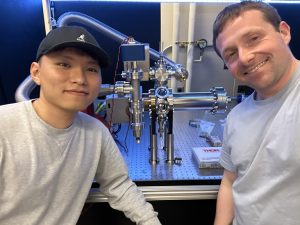
UW ECE graduate student Ohik Kwon and Parsons stand in front of a vacuum chamber built for a neutral atom quantum processor, which they recently assembled. Photo by Max Parsons
Parsons joined UW ECE in February 2022 as the inaugural director of the QT3 Lab, which was started by UW ECE and Physics Professor Kai-Mei Fu. The main goal of the QT3 Lab is to make quantum technology hardware more accessible for research and education. Parsons said that he and Fu are aiming to create an environment where there are seamless transition opportunities between these two areas. Three months after he joined, the QT3 Lab received an infusion of congressional funding, brought in by the UW Office of the Provost and Washington state Senator Maria Cantwell. This financial support enabled Parsons and Fu to significantly expand their vision for the Lab and purchase state-of-the-art equipment.
Parsons has received repeated feedback that the QT3 Lab is unique and one of the best of its kind in the nation. In addition to being a research hub, it provides undergraduate and graduate students with hard-to-find research opportunities. Another unique thing about the QT3 Lab is that it is housed in an engineering department rather than a physics department. A typical undergraduate curriculum in electrical and computer engineering does not include a significant amount of coursework in quantum mechanics; however, UW ECE offers undergraduate students a Quantum Technologies Pathway to graduate studies, which is part of what makes the Department a good fit for the Lab.
“My hope is to foster collaboration between engineers and physicists to help solve the big problem of scaling up quantum computing systems.” — UW ECE Research Assistant Professor Max Parsons
The QT3 Lab is highly interdisciplinary. It involves stakeholders from across campus and around the Pacific Northwest. Students and faculty come from ECE, computer science and engineering, mechanical engineering, chemistry, materials science, and physics. The QT3 Lab is also collaborative within quantum technology development itself. The Lab pulls in those like Parsons, who is working on projects in cold atoms, as well as researchers who are studying solid-state defects, trapped ions, and other types of quantum systems. This enables an approach to evolving quantum technologies from multiple, often complementary perspectives.
Teaching, mentoring and undergraduate research opportunities
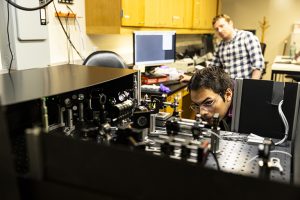
UW ECE graduate student Enrique Garcia and Parsons examine a diamond sample via a confocal microscope in the QT3 Lab. Photo by Dennis Wise / University of Washington
Parsons became a research assistant professor in February 2024. He is now in the midst of growing the QT3 Lab and his research team, adding more graduate students this quarter. Since Parsons joined UW ECE, the QT3 Lab has developed a strong track record of providing unique research opportunities for undergraduate students, and he said he sees that continuing. For example, Parsons is collaborating with Fu on developing a quantum processor based on nitrogen vacancy centers in diamonds. Until this quarter, the research team for this project was entirely undergraduates, with supervision from Parsons and Fu. The team produced a paper, published in Applied Physics Letters, and the lead author, Asher Han, who was a UW undergraduate studying physics when the research started, went on to spend a year as a research scientist and post-baccalaureate student in the QT3 Lab and at UW ECE. Han is now a graduate student in electrical engineering and computer science at MIT. The initial stages and proofs of concept of Parsons’ cold atom research at UW ECE were also performed by undergraduates in the Engineering Innovation and Entrepreneurship, or ENGINE, capstone program. Under Parsons’ supervision, this student team developed electronics for image processing in real time to detect cold atoms. Yet another undergraduate research project led by Parsons was designing a teaching apparatus for ion trapping. This produced another paper, currently in preprint, and it is a demonstration of an instructional lab Parsons hopes to make accessible to other institutions.
Over the last two years, Parsons has mentored many students in his role as a research scientist and director of the QT3 Lab. He has been a mentor for multiple capstone programs, including ENGINE at UW ECE as well as the Accelerating Quantum-Enabled Technologies (AQET) traineeship (as described on the Amazon Web Services’ blog) and the UW Graduate Certificate in Quantum Information Science and Engineering, which are both offered through QuantumX, where Parsons is a faculty member. Going forward, he will be teaching courses at UW ECE, including “Introduction to Quantum Hardware” in the Department’s Professional Master’s Program and a graduate-level course in quantum optics. Parsons said he is looking forward to teaching undergraduate courses as well. Having been a first-generation college student, he said he appreciates the importance of access to education and facilities like the QT3 Lab.
“I think it’s important to create a space to be able to train students who aren’t necessarily coming in with advanced math or programming skills because it may turn out that those students, with the right training, are the brightest ones to do this sort of work,” Parsons said. “I think we shouldn’t limit ourselves as a society. We all need access. We should make the pool of people we’re drawing from as big as possible.”
Research collaborations, outside activities and long-term goals
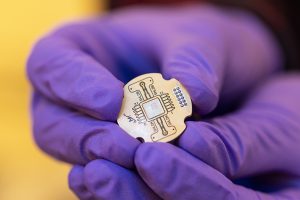
A close up of the diamond sample for the nitrogen vacancy quantum testbed professors Fu and Parsons collaborate on with their students. Photo by Dennis Wise / University of Washington
Parsons is collaborative in his work and community-oriented in his leisure activities. His UW ECE collaborators include Fu and Assistant Professor Sara Mouradian. He is also in talks with professors Mo Li, Arka Majumdar, and Sajjad Moazeni to do joint research projects. Outside the Department, he has collaborated with Boris Blinov, a UW professor in the physics department, and he is in discussions about possible future collaborations with Subhadeep Gupta, who is another physics professor at the University. Parsons is also engaged in bringing faculty across campus who are involved in quantum research together for lunches and quarterly meetings. Outside of the UW, Parsons’ hobbies include mountaineering and music. He is active with The Mountaineers, a Seattle climbing club, and he has led glacier-climbing expeditions. He also is part of Seattle Pro Musica, an award-winning, local choral ensemble.
Over the long term, Parsons said he hopes to add more items to the photonic toolbox that will allow researchers to better control quantum systems. To this end, he and Fu, along with David Ginger, a professor in the chemistry department, are planning to install an atomic force and scanning tunneling microscope for researchers in the QT3 Lab during winter quarter. They also plan to teach students the fundamentals of how this device works in an instructional lab where students can build their own atomic force microscope. This fits into their overall plan of using the Lab as a training ground for students to go on to do research with sophisticated instrumentation.
“In research, what I find most exciting is the prospect of developing new tools that we can use to probe quantum phenomena more deeply,” Parsons said. “In teaching, I think something that will probably be able to anchor me forever is that I am contributing to making people better at something technical and hopefully helping them to have better, more fulfilled lives.”
For more information about UW ECE Research Assistant Professor Max Parsons and the QT3 Lab, visit his bio page.

